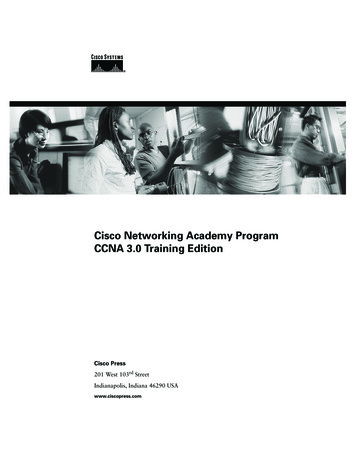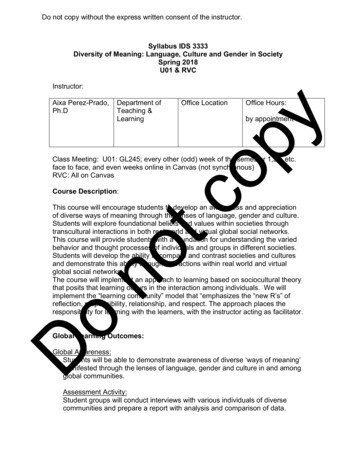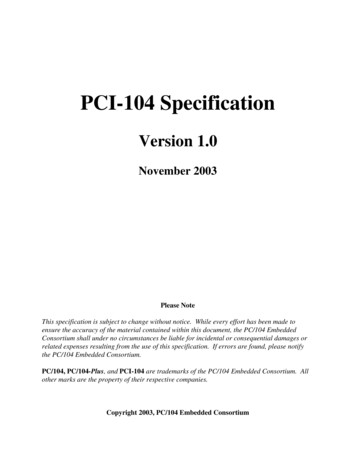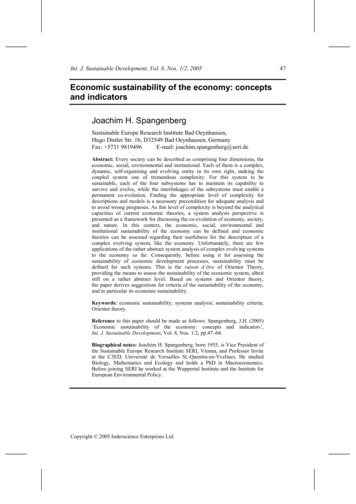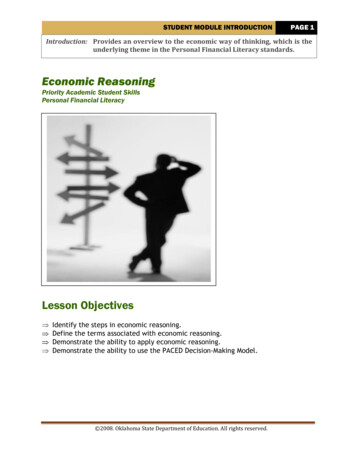
Transcription
STUDENT MODULE INTRODUCTIONPAGE 1Introduction: Provides an overview to the economic way of thinking, which is theunderlying theme in the Personal Financial Literacy standards.Economic ReasoningPriority Academic Student SkillsPersonal Financial LiteracyLesson ObjectivesIdentify the steps in economic reasoning.Define the terms associated with economic reasoning.Demonstrate the ability to apply economic reasoning.Demonstrate the ability to use the PACED Decision-Making Model. 2008. Oklahoma State Department of Education. All rights reserved.
Student Module Introduction2Personal Financial Literacy VocabularyChoice: Decision made or course of action taken when faced with a set ofalternatives.Cost/benefit analysis, risk/reward relationship: A tool used to choose amongalternatives; weighing the cost of a product or service against the benefit(s) it willprovide.Disincentive: A factor or disadvantage that discourages people from doing something.Incentive: Any reward or benefit that motivates people to do something.Opportunity cost: The value of the second-best alternative that a person gives upwhen making one choice instead of another.Scarcity: An economic condition created by an excess of human wants over theresources necessary to satisfy them; an inability to satisfy all of everyone’s wants.Trade-off: Giving up a little of one thing in order to get more of something else.IntroductionMost choices in life have very little to do with money. However, theresults of those choices generally have costs that may eventuallydetermine how much money we have.Have you ever heard the saying, “There is no such thing as a freelunch?” Basically, it means there are no free rides in life. Even ifadvertised as free, there is still a cost, and somebody has to pay.LessonTo understand the roles of choices, we need to start by examining a typical day.The alarm clock goes off and what happens? We make a choice. We can chooseto get up, hit the snooze button and sleep a little longer, or turn off the alarmand sleep later. Once we get up, we choose what to wear, what to eat, whereto go, who to see, and when to go back to bed. 2008. Oklahoma State Department of Education. All rights reserved.
Student Module Introduction3All of those choices are part of life. Think about that first choice: getting up, hittingthe snooze button, or turning off the alarm. If we choose to hit the snooze button,what do we gain? We gain an extra ten minutes of sleep, right? What do we lose? Welose ten minutes of time that we might spend with a friend, to study for an exam, towatch TV, to play video games, or whatever. The extra ten minutes of sleep is abenefit; the ten minutes lost by doing another activity is our cost.When we make choices, we try to determine how we can get the most benefit for theleast cost. That process means that we have priorities or goals. If spending time witha friend or playing video games is important to us, we make that a priority. That iswhy we give up the opportunity to sleep ten more minutes. Of course, the opposite isalso true. If sleeping ten more minutes is important, that is our priority, and we giveup the extra time with friends or playing video games.The idea of considering our benefits and our costs is called “the economic way ofthinking.” It simply means that we have some awareness about what we gain, andsome awareness of what we give up; that awareness helps us decide which option isbest.Of course, sometimes our choices do not turn out as weexpected. Why is that?Maybe we had a lack ofinformation when making a decision. Suppose we get up,look outside and see the sun is shining without a cloud inthe sky. With just that amount of information we do notsee any need to find our coat or umbrella. We wouldexpect it to be nice outside, and we would dressaccordingly. But, what if the DJ on the radio says that it iscold or that a rain storm is coming? Would that changewhat we wear? It probably would because the DJ gave usadditional information.All choices are not as simple as what to wear. Some choices are very complex, whichmakes it more difficult to make a good decision. If we are deciding which car to buy,or where to go to college, there is a lot more to consider. Even still, the process is thesame. Our goal is to determine how to get the greatest benefit for the least cost, andwe choose the alternatives that we think will accomplish that goal.In the box below, list all of the choices you have made (or will make) today: 2008. Oklahoma State Department of Education. All rights reserved.
Student Module Introduction4Why We have to Make ChoicesIt would be great if we could just have everything and not have to worry about it?Well, maybe so, but that is not very realistic. Unfortunately, we make choicesbecause we cannot have everything we want. Even the wealthiest people in the worldmust decide where to go and what to do. Their list of choices may be different fromyours, but still they must choose.“As simple as it sounds, we all mustWe must make choices because we have limitedtry to be the best person we can: byresources. This problem is called scarcity. Asmaking the best choices, by makingindividuals, limited resources (time, money,the most of the talents we've beenspace, etc.) keep us from having everything wegiven.”want. The same is true for society: there is onlyMary Lou Rettonso much land and so many workers (resources)Olympic Gymnastthat must produce all of the things that peoplewant.Can you think of a situation where people have disagreed over how to use a particularresource? Imagine that your town decides to build a new school on a vacant lot nearthe highway. The town needs a new school, and this vacant lot is a good location.That land is owned by the Jones family. Should the Jones family sell it so that aschool can be built? The answer is: It depends.(Note: In Handout 1, you will help the Jones family decide. Right now, you needmore information before advising them.)Opportunity CostUsing the Jones family’s vacant lot as an example,suppose that someone wants to build houses on thatland instead of a school. Without knowing anythingelse, you may still think building a school is best.Building a new school on the land means you cannotbuild new houses on it. Your opportunity cost forbuilding a new school is not being able to build newhouses. However, if you want to build new houses,then you cannot build a new school. That means youropportunity cost for building houses is not building anew school.This cost is called an opportunity cost. By building a new school, you give up theopportunity to build new homes on that land. By building new homes, you give up the 2008. Oklahoma State Department of Education. All rights reserved.
Student Module Introduction5opportunity to build a new school. An opportunity cost is your second best choice—thechoice you gave up.Before going on to the next part of this lesson, look back to the first box in this lessonwhere you listed all of the choices that you have made, or will make, today. Usethose choices to fill in the table below:Today I decided (or will decide) to:My opportunity cost for this choice is:1.2.3.4.5.When using this kind of cost/benefit analysis, we use incentives to measure our costsand our benefits. An incentive is a reward for our behavior. A disincentive is apunishment for our behavior. Choices with positive outcomes are always better thanchoices with negative outcomes. For example, it is better to do your homework andget a good grade (incentive) instead of receiving a zero for missing the assignment(disincentive).Another example: Suppose you have a part-time job after school and on weekends.What happens to your wages if you are always on time and do whatever you areassigned to do at work? Generally, we get to keep our job—and we may even get a payraise or a bonus. Those are also incentives.Take a minute to reflect on these questions:If we get the same outcome or reward as people who rarely cometo work, do a poor job, cause trouble and fail to get theirassignments completed, why should you even try to do the rightthing?If there is no reward for good behavior, or no punishment for badbehavior, what is your incentive to be a good employee? 2008. Oklahoma State Department of Education. All rights reserved.
Student Module Introduction6Our behavior is shaped by the incentives and disincentives available to us. Thoseincentives generally relate to rules, regulations and laws imposed by different groupsin different settings.In the following box, list three incentives and three disincentives.IncentivesDisincentivesWhen making a choice, do you prefer incentives or disincentives? Why?Now that you have a better idea of how to make good choices, here is youropportunity to help the Jones family make a decision about selling their vacant lot.COMPLETE: What Should the Jones FamilyDo with their Vacant Lot? -- Activity 1Ask your teacher to review your answers before continuing this lesson.What did you learn about making choices from this activity?How will it influence the way you make choices? 2008. Oklahoma State Department of Education. All rights reserved.
Student Module Introduction7PACED Decision-Making ModelMaking good decisions about simple matters will help us make good decisions aboutmore complex, important situations. Decision making is a process. That means itinvolves action to achieve the desired results. The PACED Decision-Making Model canhelp us make better choices with better outcomes.The five steps to good decision making include:P State the PROBLEM.A List the ALTERNATIVES.C Identify the CRITERIA.E EVALUATE the options, based on the criteria.D Make a DECISION.PROBLEM: What decision do you need to make? Are you trying todecide which pair of jeans to buy? Which movie to see? Where to gofor dinner with friends? Where to attend college? To solve aproblem, start by writing down what decision must be made.ALTERNATIVES: Each of the questions above has several possible answers, whichmeans you have a lot of options from which to choose. Make a list of all of thepossible choices that you have.CRITERIA: What is important to you? What are you using to measure your options? Forexample, suppose your problem is deciding where to have dinner and you are trying tochoose which place serves the best pizza. Some of the criteria might include price,location, quality of food, buffet or no buffet, and so forth.EVALUATE: How well does each option meet your criteria? If your favorite pizza placeis The House of Pizza, it might not be the best choice if it takes an hour to get there—especially if you only have an hour to eat before the movie starts.DECIDE: Based on your evaluation of the options you have listed, what is the bestchoice for you? It may not be your favorite place, but it may be the best solution toyour problem at this time.When making choices, oftentimes we must make trade-offs. A trade-off means thatwe give up a little of one thing in order to get more of something else. With the pizzaexample, we may give up the great tasting pizza at The House of Pizza to get a closerlocation. We still get pizza, even though it may not be our favorite, and we are ableto make it to the movie theater before show time.Source: Financial Fitness for Life, published by the National Council on Economic Education. 2008. Oklahoma State Department of Education. All rights reserved.
Student Module Introduction8COMPLETE: Making a Decision – Activity 2Ask your teacher to review your answers before continuing this lesson.ConclusionIt would be great if we could just have everything we want without having to makechoices. While it may be fun to fantasize about that idea, it is not very realistic. Gooddecisions are well thought out and based on the information we have at the time wemake the choice. Making good choices takes a little time and effort, but the resultsare worth it. The benefits of gathering information and making informed choices faroutweigh the costs of just hoping or guessing. Good choices can also save us valuableresources, like time and money. 2008. Oklahoma State Department of Education. All rights reserved.
Student Module Introduction9Name: Class Period:Economic ReasoningReview Lesson IntroductionAnswer the following questions and give the completed lesson to your teacher to review.1. Why do we have to make choices?2. Name the three types of scarcity.3. List the steps in making a decision.4. What is the opportunity cost of going to a movie instead of going to the mall? 2008. Oklahoma State Department of Education. All rights reserved.
Student Module Introduction10Name: Class Period:What Should the Jones FamilyDo with Their Vacant Lot? – Activity 1The Jones family has a dilemma. They own a vacant lot on the edge of town, but wantto sell it. Because it is on the main highway, the land has a high value. The Jonesfamily is one of the original families in the community, having settled there over 100years ago. They want to be sure that whoever buys the land uses it to benefit thecommunity and they want the townspeople to be happy with their choice.Once the FOR SALE sign went up, they had four groups who want to buy the land.Each group would give the family the same amount of money, but they are not surewhich group is the best choice to buy it. Remember, the family’s goal is to do whatwill provide the greatest benefit to the town.Can you help them?Group 1: The local school board wants to build a new school, and the Jones land is aperfect location. People in the community could easily come and go to the events atthe school and busses would no longer have to drive down the city’s narrow streets todrop off students at the school. Building a new school on theedge of town would provide opportunities for the district toexpand and have new, improved facilities for all grade levels.Some parents worry about their children going to school on sucha busy highway, and others are concerned about having to drive all the way acrosstown to take their children to school. Others are concerned about removing theproperty from the tax rolls because schools do not pay property taxes. They also areconcerned about finding the money to pay for a new school.Group 2: MEGAMALL, Inc., wants to build a new shopping center in town. The newshopping area would provide many jobs for people living in thearea, increase the amount of sales tax received in the community,increase the amount of property taxes paid to the school, and makeshopping more convenient for everyone in the area. The vacant lotis the perfect location because it is on the main highway, allowingeasy access for people in town as well as people in neighboringcommunities. Some of the local business people are concerned thatMEGAMALL would have a negative impact on their sales. They alsoare concerned that their employees will want to go to work for thenew stores in the mall or want higher wages to stay in their current jobs. Others areconcerned about the traffic congestion that might be caused by people coming andgoing to the mall. 2008. Oklahoma State Department of Education. All rights reserved.
Student Module Introduction11Group 3: Wid-Get Manufacturing wants to build a new manufacturing plant in thecommunity. It would provide high-paying jobs for people in the community and wouldattract workers from other communities to move into town or shop there. Othercompanies who do business with Wid-Get have indicated they may relocate to thatpart of the state, too. The vacant lot is a great location becausethe big trucks can easily come and go from the facility because it ison the main highway. And, it would be a convenient location foremployees. The manufacturing plant would generate more propertytaxes for the schools in town and provide opportunities for growth.Some people worry about an outside employer coming into townwho has little concern for the environment or the local customs.They also worry that the plant might close down in a few years andthe building would sit empty. Others are concerned about the increased truck trafficin and around the new building, and some fear that a big employer like Wid-Getwould bring strangers to town, upsetting the local way of life.Group 4: Builduahome is owned by a local home builder who has also lived in town formany years. He went to school there and his children are currently attending the localschools. He wants to buy the land to build a new housing development andapartments so people in town have more choices in places tolive. Builduahome is known for building quality homes andneighborhoods. Developing a new area of town would providemore places to live, encouraging people from othercommunities to consider moving to town. The constructionphase would provide a lot of jobs for people in the area, manyof whom have been driving to other cities to work. The construction of homes couldbe a big boost to local businesses because Builduahome would need to buy carpeting,appliances, and tools from them—and contract with local plumbers, electricians andbricklayers. Some people in town worry about the increase in traffic as people go andcome from the neighborhood. They also fear it will attract too many “outsiders” whowould buy the houses and move to town. Others are concerned that the houses maynot sell, so they would sit empty and become rundown.Use your economic reasoning tools to help the Jones family decide what to do. 2008. Oklahoma State Department of Education. All rights reserved.
Student Module Introduction12Economic Reasoning1. We have to make choices.We cannot have everything we want because society has limited resources andpeople have unlimited wants. This difference creates a problem called scarcity.We have to make choices because of scarcity.What is the scarcity problem facing the Jones family? (Hint: How many lots dothey own and how many people want to buy it?)2. Every time we make a choice, we give up something.All choices have benefits and costs; there are no perfect choices. Each time wechoose, we gain something—but we also lose the opportunity to do somethingelse. What we lose or give up is called our opportunity cost.What are the costs and benefits of the choices facing the Jones family? Ranktheir choices from 1 to 4, with one being their “best” choice. The secondchoice you listed is their opportunity cost.1.3.2.4.In this case, the opportunity cost is building a .3. We respond to incentives.Incentives are rewards for making our choice. People will change their behavioror modify their choices as their incentives change. We use incentives toevaluate the costs and benefits of our alternatives when making a decision.Disincentives—or punishment—also plays a role in shaping our choices; we try toavoid making choices that have a negative result.What are some of the incentives and disincentives for the Jones family?Incentives: 2008. Oklahoma State Department of Education. All rights reserved.
Student Module Introduction13Disincentives:4. Economic systems influence our choices.Economic systems have rules that influence what we can and cannot do. Thoserules influence our incentives, and the incentives influence our choices. Whenthe rules change, our incentives, and our choices will also change. The rulesmay be written, such as laws or regulations—or they may be unwritten, such ascustoms and traditions.What are some possible economic systems (laws, regulations, customs ortraditions) that will influence the choice made by the Jones family?5. Choices have consequences for the future.Choices have consequences, outcomes or results that can last for many years.The choices we make today will impact our available choices for the future.Some consequences are short-term, lasting only a brief time; others are longterm, lasting for the rest of our life. What seems like a good idea or benefittoday, may be a cost tomorrow. When we make choices, we should focus onthe future. Focusing of what happened or should have happened is uselessbecause we cannot change the past.What are some possible future consequences for the land, the town and theJones family?So, what do you recommend the Jones family do with their vacant land? 2008. Oklahoma State Department of Education. All rights reserved.
Student Module Introduction14Name: Class Period:Making a Decision – Activity 2Complete this activity, using the PACED Decision-Making Model to make a decision.1. Write down a decision you need to make.2. Make a list of three possible solutions, alternatives or options.a.b.c.3. List three things that are important to you (your criteria) when making thisdecision.a.b.c. 2008. Oklahoma State Department of Education. All rights reserved.
Student Module Introduction154. Place the three possible solutions and three criteria on the chart below.Determine how well your criteria fit your possible solutions by placing a plus orminus sign in the corresponding boxes.CriteriaSolutions5. Evaluate your results. Which option is the best decision?Why? 2008. Oklahoma State Department of Education. All rights reserved.
Identify the steps in economic reasoning. Define the terms associated with economic reasoning. Demonstrate the ability to apply economic reasoning. Demonstrate the ability to use the PACED Decision-Making Model. Introduction: Provides an overview to the economic way of thinking, which is th




